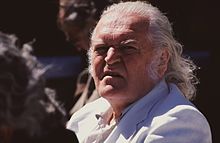Mario Merz
| Mario Merz | |
|---|---|
 |
|
| Born |
1 January 1925 Milan, Italy |
| Died | 9 November 2003 (aged 78) Milan, Italy |
| Nationality | Italian |
| Known for | Sculpture and Painting |
| Movement | Arte Povera |
Mario Merz (1 January 1925 – 9 November 2003) was an Italian artist, and husband of Marisa Merz.
Born in Milano, Merz started drawing during World War II, when he was imprisoned for his activities with the Giustizia e Libertà antifascist group. He experimented with a continuous graphic stroke–not removing his pencil point from the paper. He explored the relationship between nature and the subject, until he had his first exhibitions in the intellectually incendiary context of Turin in the 1950s, a cultural climate fed by such writers as Cesare Pavese, Elio Vittorini, and Ezra Pound.
He met Marisa Merz during his studies in Turin in the 1950s. They were associated with the development of Arte Povera, and they were both influenced by each other's works.
He died in Milan in 2003.
Merz discarded abstract expressionism’s subjectivity in favor of opening art to exterior space: a seed or a leaf in the wind becomes a universe on his canvas. From the mid-1960s, his paintings echoed his desire to explore the transmission of energy from the organic to the inorganic, a curiosity that led him to create works in which neon lights pierced everyday objects, such as an umbrella, a glass, a bottle or his own raincoat. Without ever using ready-made objects as "things" (at least to the extent that the Nouveau Realistes in France did), Merz and his companions drew the guiding lines of a renewed life for Italian art in the global context.
Many of his installations were accented with words or numbers in neon. The numbers counted off the Fibonacci progression, the mathematical formula (named for the Italian monk and mathematician Leonardo Fibonacci who discovered it) for growth patterns found in many forms of life, including leaves, snail shells, pine cones and reptile skins. The pattern is identifiable as a sequence of numbers in which any given number is the sum of the two numbers that precede it: 1, 1, 2, 3, 5, 8, etc., ad infinitum. From 1969 Merz employed the Fibonacci sequence in performances and installations throughout his career to represent the universal principles of creation and growth: climbing up the Guggenheim Museum in New York (1971) or the spire of a Turin landmark (1984), or perched in neon on a stack of newspapers among the old masters of Naples' Capodimonte Gallery (1987). In 1972 he illustrated the Fibonacci progression with a series of photographs of a factory workers' lunchroom and a restaurant progressively crowded with diners. His 1973 show at the John Weber Gallery in New York expressed the Fibonacci in a series of low modular tables. In 1990 the sequence determined the form of a spiral assembled from sticks, iron and paper across 24 meters of a hall in Prato, near Florence. An installation of Fibonacci numbers by Merz is the landmark of the Centre for International Light Art in Unna, Germany.
...
Wikipedia
